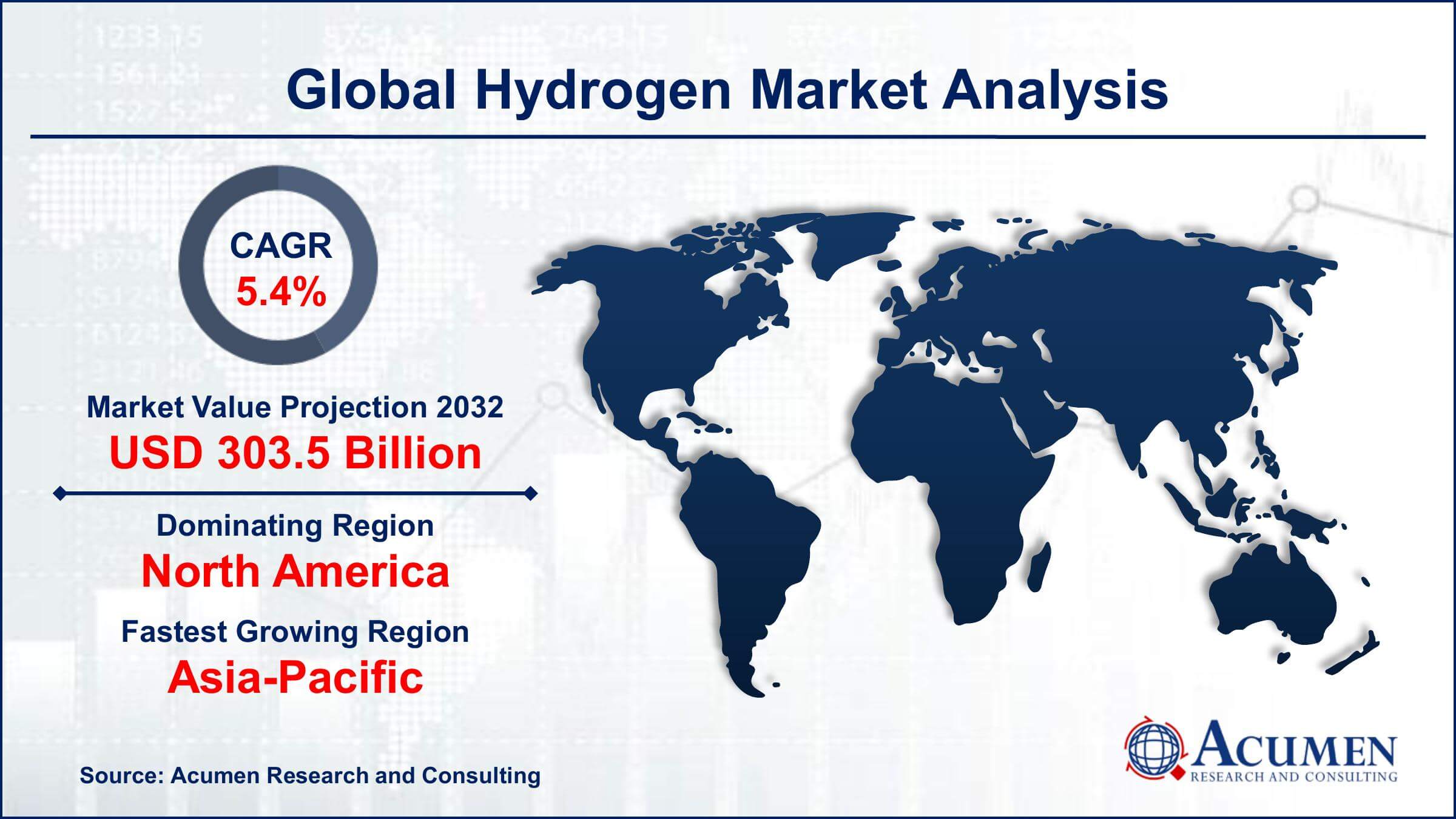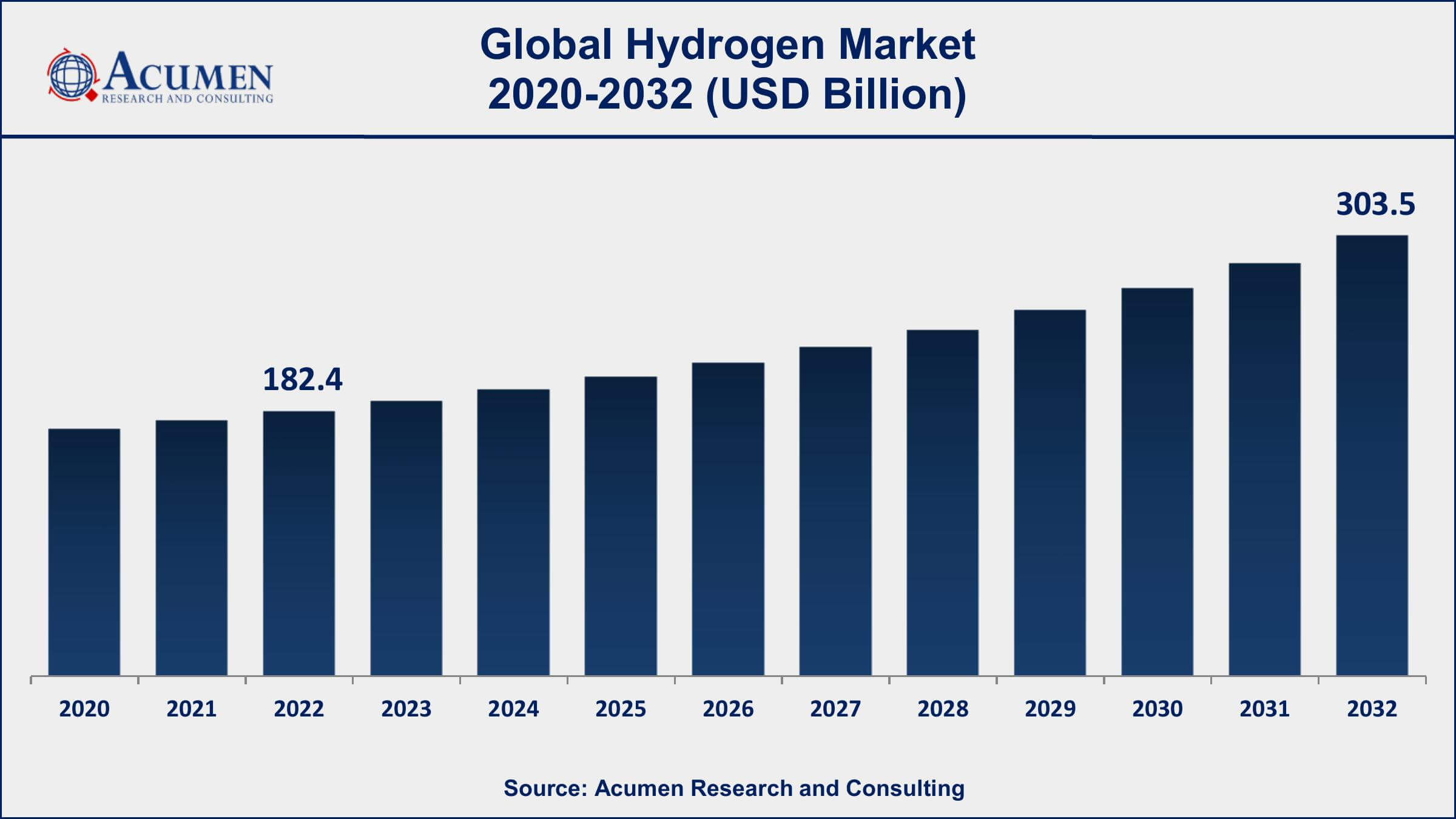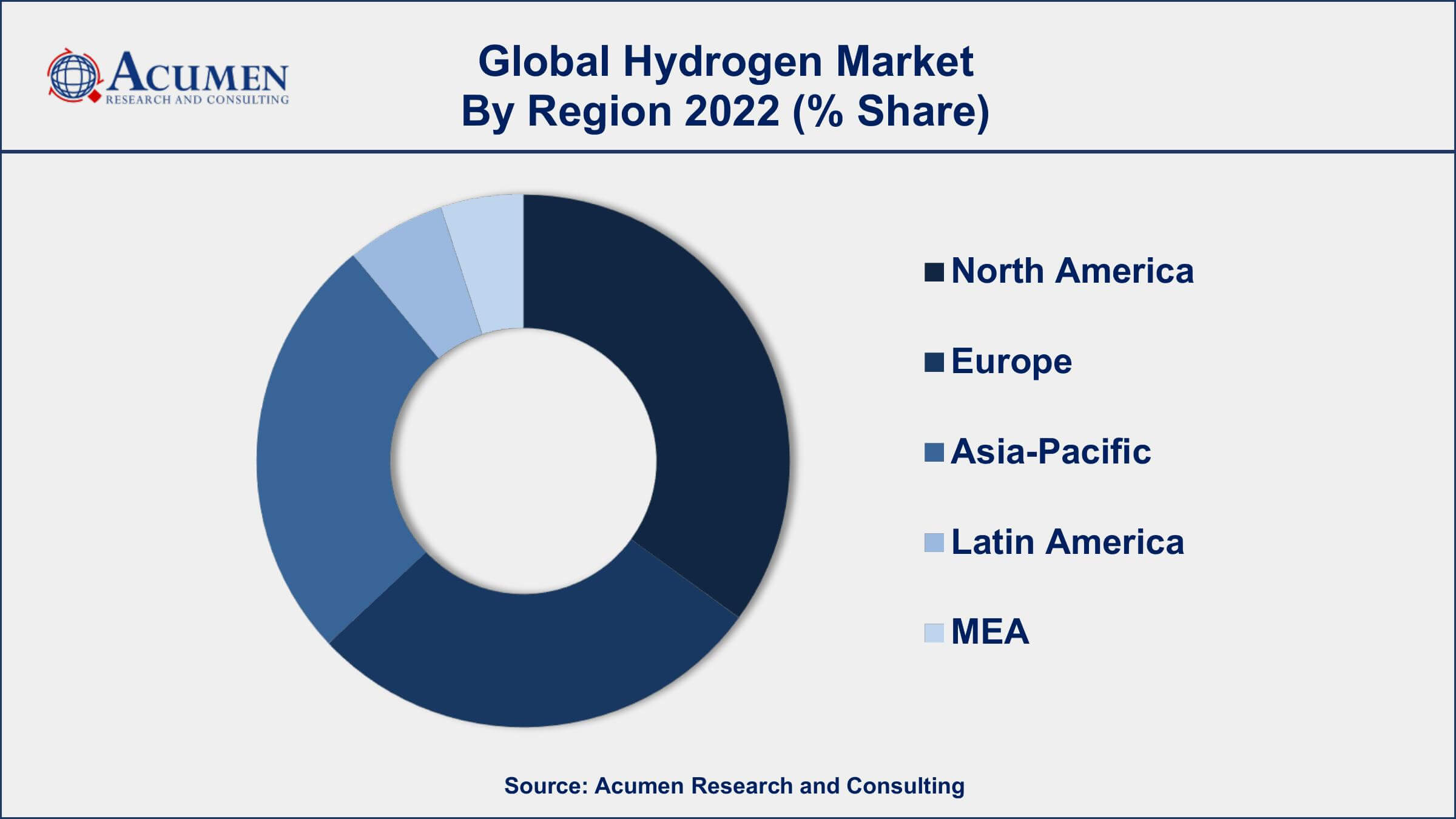April 2024
Hydrogen Market Size accounted for USD 182.4 Billion in 2022 and is projected to achieve a market size of USD 303.5 Billion by 2032 growing at a CAGR of 5.4% from 2023 to 2032.
The Global Hydrogen Market Size accounted for USD 182.4 Billion in 2022 and is projected to achieve a market size of USD 303.5 Billion by 2032 growing at a CAGR of 5.4% from 2023 to 2032.
Hydrogen Market Highlights

In recent years, hydrogen has garnered significant attention as a potential clean and versatile energy carrier. It can be produced through various methods, such as electrolysis of water using renewable electricity, steam methane reforming, and gasification of biomass. One of the major applications of hydrogen is in fuel cells, where it can be combined with oxygen to produce electricity, emitting only water and heat as byproducts. This has led to a growing interest in using hydrogen as a means to decarbonize sectors such as transportation, industrial processes, and power generation. Governments, industries, and researchers are investing in research and infrastructure development to unlock the potential of hydrogen as a sustainable energy source, aiming to reduce greenhouse gas emissions and achieve ambitious climate goals.
The market growth of hydrogen has been significant over the past few years. As countries strive to transition to low-carbon economies, hydrogen is seen as a key enabler of this transformation. Governments around the world are implementing policies and incentives to promote the adoption of hydrogen technologies. Investments are being made in the development of hydrogen production, storage, and distribution infrastructure. Additionally, industries are collaborating to create a hydrogen value chain, from production to end-use applications. This has led to the emergence of a global hydrogen market, with various sectors exploring hydrogen-based solutions to meet their energy needs while addressing environmental concerns.

Global Hydrogen Market Trends
Market Drivers
Market Restraints
Market Opportunities
Hydrogen Market Report Coverage
| Market | Hydrogen Market |
| Hydrogen Market Size 2022 | USD 182.4 Billion |
| Hydrogen Market Forecast 2032 | USD 303.5 Billion |
| Hydrogen Market CAGR During 2023 - 2032 | 5.4% |
| Hydrogen Market Analysis Period | 2020 - 2032 |
| Hydrogen Market Base Year | 2022 |
| Hydrogen Market Forecast Data | 2023 - 2032 |
| Segments Covered | By Type, By Application, And By Geography |
| Regional Scope | North America, Europe, Asia Pacific, Latin America, and Middle East & Africa |
| Key Companies Profiled | Air Liquide, Linde plc, Toyota Industries Corporation, Hyundai Motor Company, Ballard Power Systems, Plug Power Inc., Nel ASA, ITM Power, McPhy Energy, Sinopec, Mitsubishi Power, and FuelCell Energy. |
| Report Coverage |
Market Trends, Drivers, Restraints, Competitive Analysis, Player Profiling, Covid-19 Analysis, Regulation Analysis |
Hydrogen's applications span a wide range of sectors due to its unique properties. One of its notable uses is as a clean energy carrier. In fuel cells, hydrogen reacts with oxygen to generate electricity, emitting only water vapor as a byproduct. This technology has gained attention as a potential alternative to conventional combustion engines, offering high efficiency and zero emissions. Hydrogen also finds application in industrial processes like refining, ammonia production, and metal processing. In recent years, it has garnered attention for its role in decarbonizing industries by replacing fossil fuels with hydrogen as a cleaner feedstock. Additionally, hydrogen can be stored and utilized as a means of seasonal energy storage, facilitating the integration of renewable sources into the energy mix. Its versatility and potential to contribute to a more sustainable future make hydrogen a key player in the ongoing energy transition.
The hydrogen market has witnessed remarkable growth in recent years, driven by a convergence of factors that highlight its potential as a pivotal player in the global energy transition. With the increasing urgency to mitigate climate change, hydrogen has emerged as a versatile and clean energy carrier capable of addressing multiple sectors. Governments worldwide are setting ambitious emission reduction targets, prompting substantial investments in hydrogen technologies. This has led to a surge in research, innovation, and collaborative efforts across the hydrogen value chain. The transportation sector, including automotive, maritime, and aviation industries, presents a significant growth avenue for hydrogen. Fuel cell electric vehicles (FCEVs) powered by hydrogen have gained traction due to their longer ranges and faster refueling times compared to traditional batteries. Moreover, industries such as steel manufacturing and chemical production are exploring hydrogen-based processes to reduce their carbon footprints.
Hydrogen Market Segmentation
The global Hydrogens market segmentation is based on type, application, and geography.
Hydrogen Market By Type
In terms of types, the grey segment accounted for the largest market share in 2022. The grey hydrogen segment within the hydrogen market refers to hydrogen produced from natural gas through a process called steam methane reforming (SMR) without carbon capture and storage (CCS). While this method is cost-effective and has been widely used historically, it produces significant carbon emissions during the process, thus making it less environmentally friendly compared to green or blue hydrogen production methods. Despite its carbon-intensive nature, the grey hydrogen segment still exhibits growth, primarily due to existing infrastructure and lower production costs. Industries that require hydrogen for various applications, such as ammonia production, petrochemicals, and refining, often opt for grey hydrogen due to economic considerations. However, the growth of the grey segment faces challenges as environmental regulations become more stringent and companies face increasing pressure to reduce their carbon footprints.
Hydrogen Market By Application
According to the hydrogen market forecast, the petroleum refining segment is expected to witness significant growth in the coming years. Hydrogen is used extensively in petroleum refining to remove impurities from crude oil and produce cleaner fuels, such as gasoline and diesel. The growth of this segment is closely tied to the overall demand for refined products and the increasing need to adhere to stricter environmental regulations. The growth of the petroleum refining segment is also influenced by the industry's efforts to enhance operational efficiency and reduce its carbon footprint. While grey hydrogen, produced from natural gas, has historically been the dominant source for refining applications, the industry is increasingly exploring blue and green hydrogen as more environmentally friendly alternatives. Blue hydrogen, produced from natural gas with carbon capture and storage, and green hydrogen, produced through renewable energy-powered electrolysis, are gaining traction as the refining sector seeks to align with sustainability goals. Therefore, the petroleum refining segment's growth hinges on its ability to balance cost-efficiency, regulatory compliance, and environmental sustainability.
Hydrogen Market Regional Outlook
North America
Europe
Asia-Pacific
Latin America
The Middle East & Africa

Hydrogen Market Regional Analysis
North America has emerged as a dominating region in the hydrogen market due to a combination of factors that have positioned it at the forefront of hydrogen production, technology development, and market adoption. One significant advantage is the region's abundant shale gas resources, which provide a reliable and cost-effective feedstock for grey hydrogen production through steam methane reforming (SMR). This has allowed North America to establish a strong industrial base for hydrogen production, particularly in sectors like petroleum refining and chemical manufacturing, driving its dominance in the market. Furthermore, North America has been proactive in promoting innovation and research in hydrogen technologies. The region boasts a robust ecosystem of research institutions, universities, and technology companies working on advancements in fuel cells, electrolysis, and hydrogen storage. Government support and incentives have further catalyzed the growth of these technologies, allowing North America to remain at the cutting edge of hydrogen-related innovations.
Hydrogen Market Player
Some of the top hydrogen market companies offered in the professional report include Air Liquide, Linde plc, Toyota Industries Corporation, Hyundai Motor Company, Ballard Power Systems, Plug Power Inc., Nel ASA, ITM Power, McPhy Energy, Sinopec, Mitsubishi Power, and FuelCell Energy.
Looking for discounts, bulk pricing, or custom solutions? Contact us today at sales@acumenresearchandconsulting.com
April 2024
January 2025
March 2025
October 2024